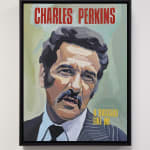Thea Anamara Perkins
A Bastard Like Me, 2021
acrylic on gessobord
40.5 x 30.5 cm
Collection of Museum & Art Gallery of the Northern Territory
Collection of Museum & Art Gallery of the Northern Territory
Further images
Thea’s NATSIAA entry is inspired by her grandfather’s story, and references his autobiography originally published in 1975. Thea explains: ‘It was important for me to reflect the radical spirit my...
Thea’s NATSIAA entry is inspired by her grandfather’s story, and references his autobiography originally published in 1975. Thea explains: ‘It was important for me to reflect the radical spirit my grandfather represents to me.’
'‘A Bastard Like Me’ is my grandfather’s autobiography originally published in 1975. Increasingly rare, we keep an eye out for copies when they surface. Reading it is like listening to him talk. I have always been captivated by the image of this small book, its flair and strong graphic. It was interesting to enlarge it and to try and capture this dynamism in paint. I think there is something of his boldness and humour in his gaze as if he was about to make a wisecrack, but also a great sadness. It was a deeply personal process using the departure point of the image and flowing into memory. Using the word ‘bastard’ was a deliberate decision: the word was shocking in 1975 and reflective of the widespread vilification he was subject to as an outspoken Aboriginal man. It also carries the idea of illegitimacy – to be disowned or without claim. There is also an aggressive tinge in the title, which is a diatribe always levelled at passionate Aboriginal people. To then flip it, and wear the term with pride has a bold complexity. It was important for me to work with this image, and the radical spirit it represents to me.’
'‘A Bastard Like Me’ is my grandfather’s autobiography originally published in 1975. Increasingly rare, we keep an eye out for copies when they surface. Reading it is like listening to him talk. I have always been captivated by the image of this small book, its flair and strong graphic. It was interesting to enlarge it and to try and capture this dynamism in paint. I think there is something of his boldness and humour in his gaze as if he was about to make a wisecrack, but also a great sadness. It was a deeply personal process using the departure point of the image and flowing into memory. Using the word ‘bastard’ was a deliberate decision: the word was shocking in 1975 and reflective of the widespread vilification he was subject to as an outspoken Aboriginal man. It also carries the idea of illegitimacy – to be disowned or without claim. There is also an aggressive tinge in the title, which is a diatribe always levelled at passionate Aboriginal people. To then flip it, and wear the term with pride has a bold complexity. It was important for me to work with this image, and the radical spirit it represents to me.’





